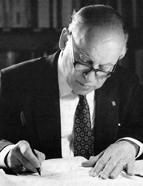

Son of Joaquim Pereira Vicente Serrão and Adriana dos Santos Veríssimo Serrão, he was 11 years old when he lost his mother, which contributed to his father playing a major role in his education. With a commercial business in the city and a republican-liberal upbringing, his father was keen to provide his son with the best education that Santarém had to offer. After completing his secondary education in 1943, the young Joaquim Veríssimo Serrão went to Coimbra to enrol at the University on 23 September in the Faculdade de Direito [School of Law], which he only attended for a year. Legal studies did not captivate him, however, and the following year, on 7 September 1944, he opted to enrol in the Historical and Philosophical Sciences course, which at the time boasted a prestigious teaching staff. The School included Damião Peres, Manuel Lopes de Almeida and Mário Brandão in the field of Modern History, and Torquato de Sousa Soares and Pierre David in Medieval History. Philosophical thought was expounded by Joaquim de Carvalho, “a profound inquirer of ideas who could not understand history without linking it to the fascinating world of philosophy”; and Sílvio Lima, “who introduced students to the study of Renaissance anthropocentrism and theocentrism” (Primeiras jornadas de História Moderna, 1986, p. 5) with a depth that young students eagerly absorbed. He was also a disciple of Aristides de Amorim Girão, the renovator of geographical studies; in Art History, he briefly met Vergílio Correia; in complementary courses, he had the renowned teachers Maximiano Correia and José Correia de Oliveira. In a statement on the “Office of the Historian” given in 1989 to the journal Ler História, he summarised his education in Coimbra as follows: “While some teachers leaned towards documentary research, others leaned towards historical reflection as the basis of an authentic culture.” He also mentioned the easy access that students then had to the latest publications in the field of historiography, including foreign books and journals, particularly French ones, in the institutes attached to the Faculdade de Letras [School of Arts and Humanities], and his frequent visits to the rich Joanina Library, “a mandatory stop for anyone who felt the flame of historical research.” (JVS, Meio século ao serviço da Universidade e da História [Half a century in the service of the University and History], 2000, p. 11). However, his taste for research had already begun during his high school days, when he spent hours in the Braamcamp Freire Library. Upon completing his degree in 1948, confident in the consistency of his training, he decided to submit his dissertation in the same year. Manuel Lopes de Almeida tried to dissuade him from doing so, considering it reckless, but the student replied that he was doing it because he did not want to burden his father with another year in Coimbra. He gave his dissertation the title Sentido da História.
This work is financed by national funds through FCT - Foundation for Science and Technology, I.P, in the scope of the projects UIDB/04311/2020 and UIDP/04311/2020.
